Brewing in Chuvashia

Yasna main building |
Suddenly, the bus drove out of the forest, onto a bridge spanning an enormous river, deep blue in the sunshine, and so wide it looked more like a lake. This was the Volga. We had left the northern forest zone for the fertile Russian south. Except this part of it wasn't only Russian. We were about to make the third stop on our Russian farmhouse ale expedition, "only" 800 kilometers east of Moscow. From the previous stop in Kirov we'd travelled south to Chuvashia.
The Chuvash are a Turkic people, living on the south side of the Volga, mid-way between Nizhniy Novgorod and Kazan, where about a million of them live in the Chuvash Republic. The region is densely populated and heavily farmed, since the soil in Chuvashia is famously fertile. During the Soviet era Chuvashia was chosen to be the hop-growing region of the Soviet Union, so hop farming was a major industry here. Serebryanka, a grandparent of Cascade, comes from Chuvashia.
Finding a brewer to visit in Chuvashia was not exactly easy, but eventually I found the Yasna Eco-village. It's a local government-funded project to showcase Chuvashian traditions to interested visitors. Demonstrating the local brewing was right up their alley.
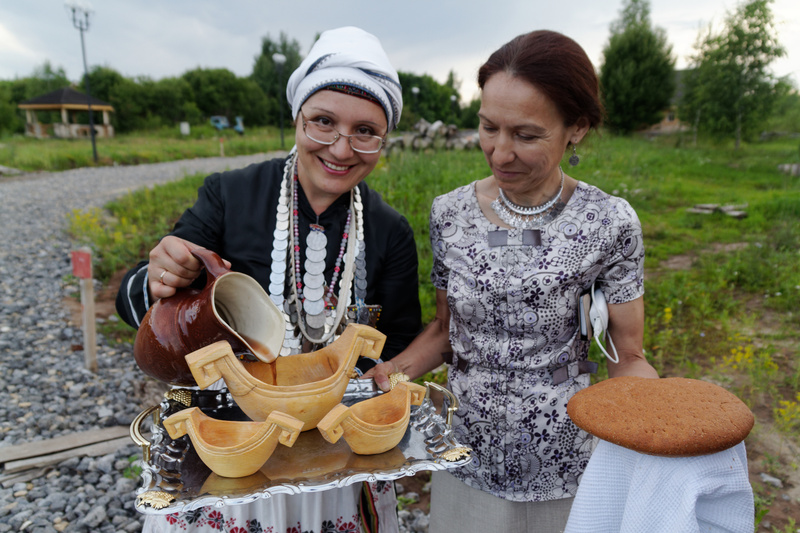
Ritual welcome from Elena (left) and Marina at Yasna |
Coming out of the car outside Yasna we were met with a formal welcome ceremony of bread and kvass by Elena Klementyeva, who seems to run Yasna, and Marina Ivanovna. Marina would demonstrate the brewing for us. She'd grown up with the brewing, but even so they had decided to give her some extra support, so two older women, Anna and Zoya, came along as well. All three of them had been brewing beer all their adult lives. Marina, however, was the one leading the demonstration.
This trio was quite a sight that morning in their formal best clothes, tanned and brown, with shining blue eyes. Two of them thin and wiry with a spring in their step, the last broad and powerful. All three were obviously in excellent physical shape. A life of hard physical labour under the sun is clearly not the worst thing you can do to yourself.
The Chuvashian farmhouse ale is called "saura", obviously related to the Komi "sur" (and Hungarian, and Finnish). So why would a Turkic people use a Finno-Ugric word for something so ancient and important as beer? Well, according to Marina the Chuvash were originally nomads, and only settled in Chuvashia in the 13th century. At that point, the area was dominated by Finno-Ugric peoples, and the Chuvash probably learned grain growing and beer brewing from them, also taking their word for beer.

Sprouting on top of the oven |
We started with the malting, because Marina makes her own malts from rye. She says the Chuvash also use barley or barley and rye, but she always uses rye. The rye is sprouted by wetting it with warm water, about 40C, once a day. It's placed in a kind of rack on top of the great Russian oven, and covered with pillows. Every day more warm water is added, and after 3-4 days the rye has sprouted enough.
To dry it a fire is started in the oven and allowed to burn down. Then the ashes are removed, and the oven is cleaned with oak branches with leaves and a wet towel, so that the inside is really clean. The green malts are placed inside the oven in a layer about 5cm deep, and left to dry. After 12 hours, they heat the oven with a new fire, then again after 24 hours.
Marina gave us some malts to taste, and they were unpleasantly hard to chew, tasting of caramel and rye. As Sasha pointed out, it was basically caramel malts. That's not so strange, because this is how you make caramel malts: high initial heat first producing a little sugar in the malts, then caramelizing it.
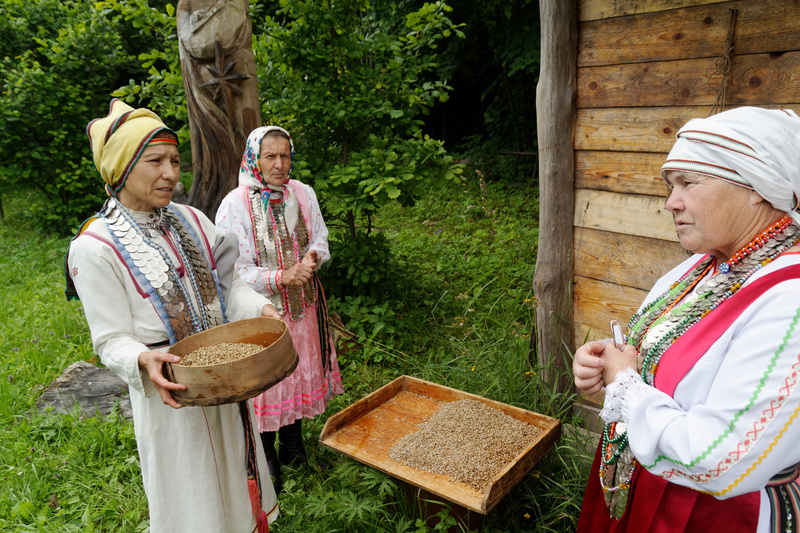
Malt cleaning |
After the malts are dried they are cleaned by throwing them in the air so that the wind blows away the impurities.

Chuvashian mill wheel |
The grinding of the malts is interesting: in Chuvashia people didn't have suitable stones to make querns, so they made them of wood instead. Of course, grinding with wood isn't going to work very well, so they insert bits of metal looking like big staples into the wood. These are made from broken tools and similar leftover metal items. I got to turn the quern for a little while, grinding malts, and it's not too heavy to turn, but doing it for a long time would be tiring. (It's not clear to me if people still use these or not.)
The brewing is based around a metal vessel that Marina calls the "korchaga". It's the same name and shape as what Dmitriy and Marina in Kudymkar used. To brew Marina heats water until it's so hot you can only just about keep your hand in it. That's not very precise, but Marina tested it once with a thermometer, and found that it was 45C. The water is then poured onto the malts in the korchaga.
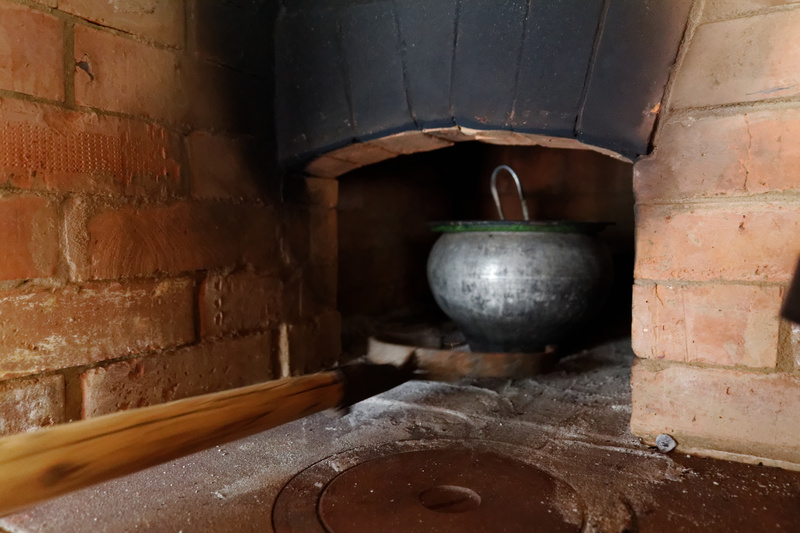
Retrieving the korchaga from the oven |
The korchaga is then placed in a pre-heated oven, which must not be too hot. To check, hold your hand in it, and if you can stand it then the temperature is right. Of course, this is hotter than 45C, because now your hand is in air, not water. It's important that the oven not be too hot, because you don't want the mash to boil. The korchaga is then left in the oven for 12-20 hours.
Just as we saw before, the oven is used to heat the mash, although Marina points out that you don't have to do it this way. You can also use an outdoor fireplace to heat the mash. I assume in that case the brewer uses an ordinary kettle instead of a korchaga.
Marina had put the korchaga in the oven the day before, and now we got to see her take it out. The korchaga was then carried from the house with the great oven to an outdoor fireplace where the rest of the brewing took place. While we were doing this, Marina was explaining to Sasha in Russian. In the pause when he translated to me, Marina seemed to be teaching Anna and Zoya Russian brewing terms. Anna turned to me, saying in Russian "the Chuvashian people really like to work." This thought made her so happy that, after Sasha had translated, she repeated it to me one more time in Russian for emphasis, beaming.
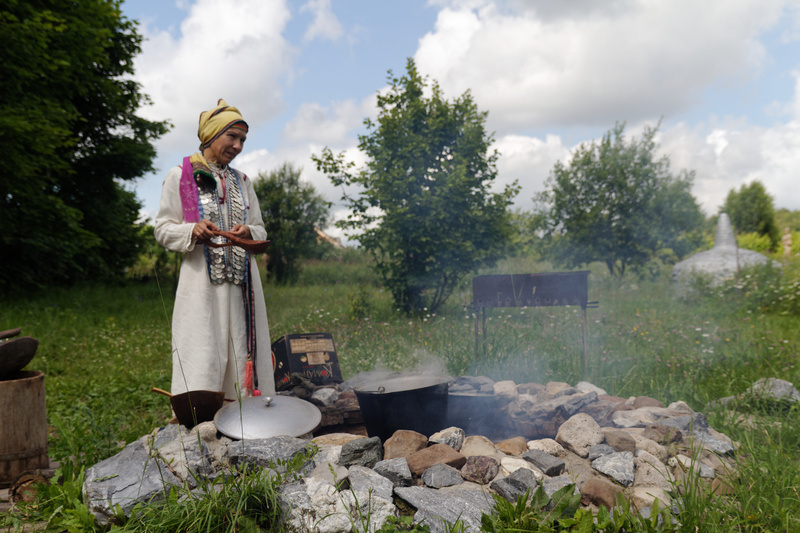
Marina brewing outdoors |
Having been retrieved from the oven, the korchaga was now brought over to a big outdoors fireplace built of stones. Two metal kettles were waiting, one small and one large. Water was added to both and the fire started. As the water heated white spots formed on the surface. Marina removed these with a spoon, and explained that it was minerals from the water. This water was from the local waterworks, but usually they use water from a spring, and that has less minerals.
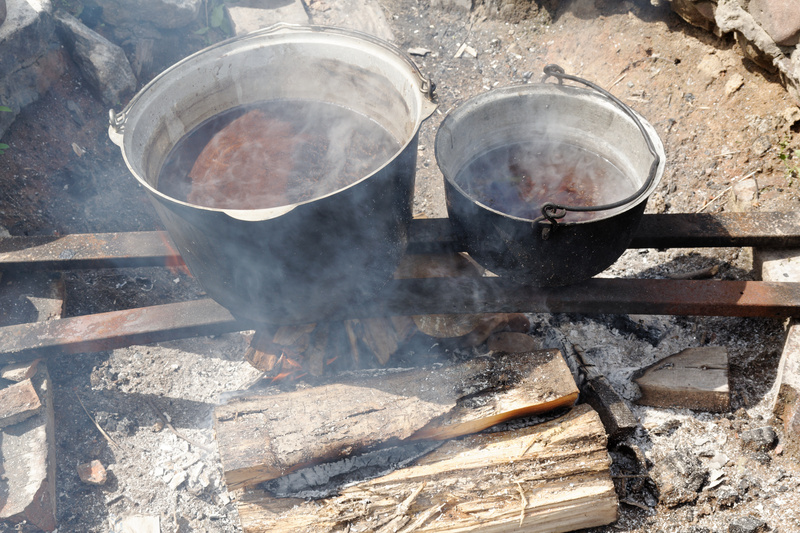
The mash and the hop tea. Note how the firewood is collected under the mash, but not the tea. |
The small kettle was for making hop tea, "sarashu" in Chuvashian. A couple handfuls of home-grown hop cones are added to the pot, and left to steep in hot water for 2-3 hours. The hop tea shouldn't boil, Marina told us. I guess the reason is to not make the beer too bitter. We tasted the hop tea, and even without boiling it was highly aromatic and bitter.
After the wort has been cooled, before the yeast is pitched, the hop tea is added to taste. This is a smart way to do it, because with home-made malts, mashing with no thermometer, and home-grown hops, you can't rely on a recipe to get you the right sweet/bitter balance. So hopping to taste makes perfect sense. In Chuvashia it's also customary to let people add hop tea according to personal preference as the beer is served.
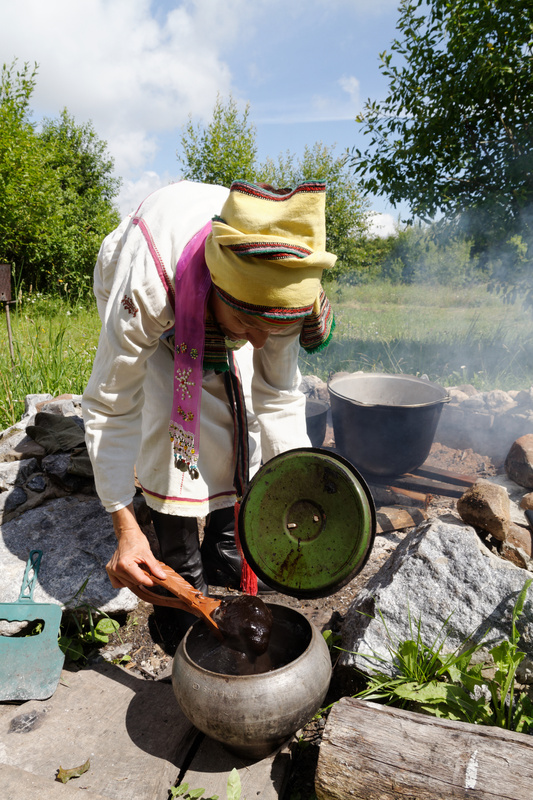
Ladling from the korchaga into the kettle |
The big kettle was for the mash. The mash was ladled with a big spoon from the korchaga into the water, and heated over the fire. The mash at this point looked completely black, almost like tar, even when diluted with water. I tasted it, and it was a bit like faintly acidic coffee, muddy and with soft, mushy grains in it. They'd had problems with the sprouting, I was told, so the wort was not as sweet as it should be.
Now Marina boiled the mash for 2-3 hours. And the mash really must visibly boil. The three women concentrated the firewood underneath the big kettle and fanned it to really get it going. Marina said that if necessary, they could add hot stones to the mash, to get it to boil faster. (Which would be stone brewing.)
At this point there was a bit of a break, and the women decided to liven it up by singing brewing songs. It turns out that the Chuvash have a whole range of songs relating to beer. Some are songs that are sung when the beer is served, others are sung during the actual brewing.
Here are the lyrics for two of the songs. Be warned that the lyrics have been mangled through translation from Chuvash to Russian, and then again from Russian to English. The originals are probably more poetic.
First song:
Mama and papa, let's gather the whole family,
Growing rye, living together,
In the autumn when harvesting grain,
Let's brew the beer.
Second song:
Let it be the pot full of malt,
the table with the whole family,
Let the beer flow slowly,
There will be a cellar full of barrels.
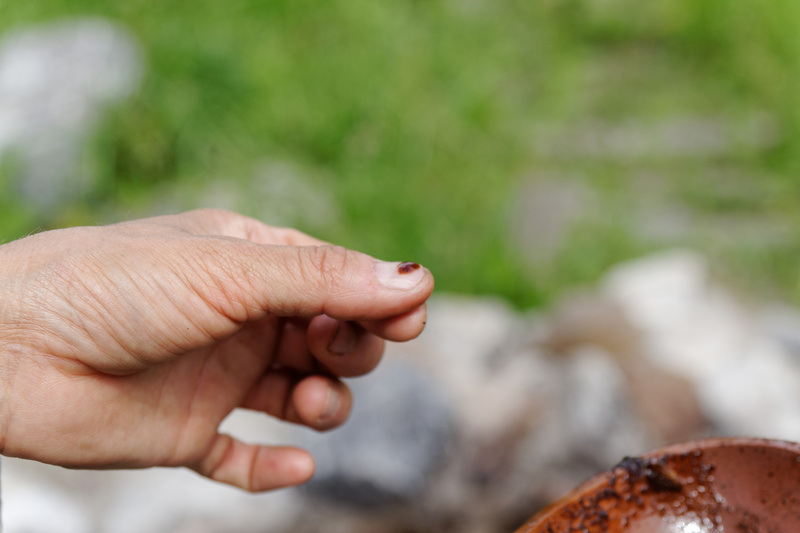
The mash is ready |
The mash has finished boiling when a drop of the mash, placed on a fingernail, sits in a tidy drop without running off. Eventually, Marina did the test and found that the mash had finished boiling. Then it was time for the lautering.
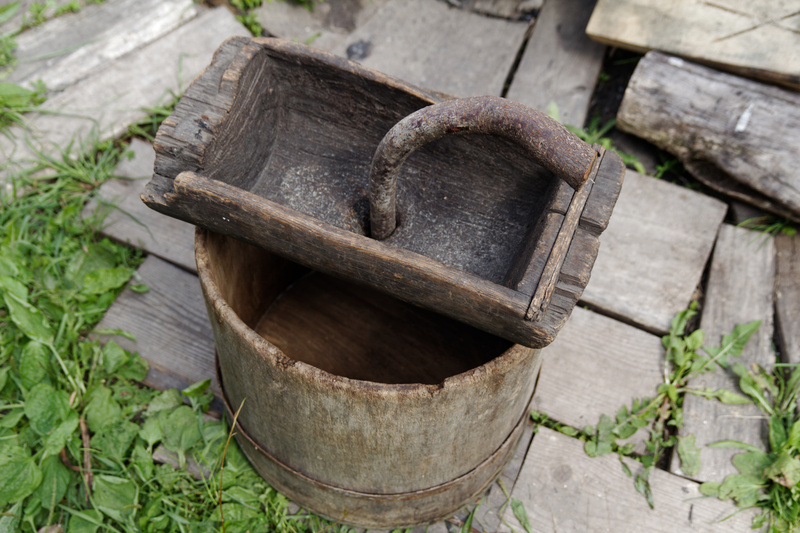
Lauter vessel |
Marina brought out the smallest lauter, uh, vessel I've ever seen. It was shaped like a trough, with a hole in the middle, which is opened and closed with a rod. The shape is clearly reminiscent of the Finnish lauter tun, the kuurna, but the rod for opening and closing is more like the Baltic lauter tun with a hole in the bottom. It's kind of a hybrid lauter tun.
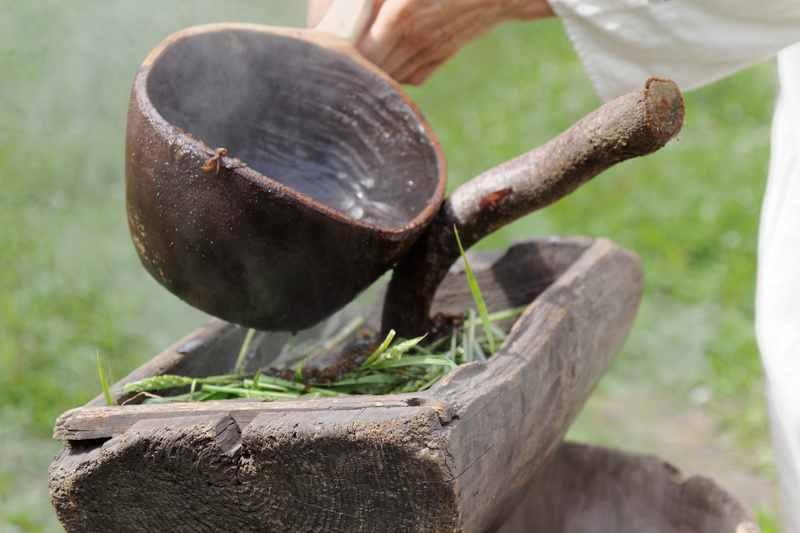
Marina lautering |
The filter is made of linden branches and oat straw. Today the straw is green, but usually they brew in winter, and then the straw is of course dry. Marina slowly ladles the mash on top of the filter, and steaming hot wort runs from the lauter vessel into the wooden fermenter below.

Hot stones into the wort |
Now Marina did something strange: she took a couple of hot stones from the fire, and dropped them into the wort. The stones disappeared into the black wort, leaving only spots of boiling wort for a while above them to show where they'd sunk. This is the only instance I know of someone using hot stones in the wort (see blog post). What's even more confusing is that Marina made no attempt to actually boil the entire wort. She was satisfied with these few stones and then proceeded to cool the wort.
Cooling the wort was done by simply leaving the wort in the wooden vessel, placing a cloth over it, and waiting. In winter I guess this could be pretty quick with such small batches, but now in summer it took a good while.
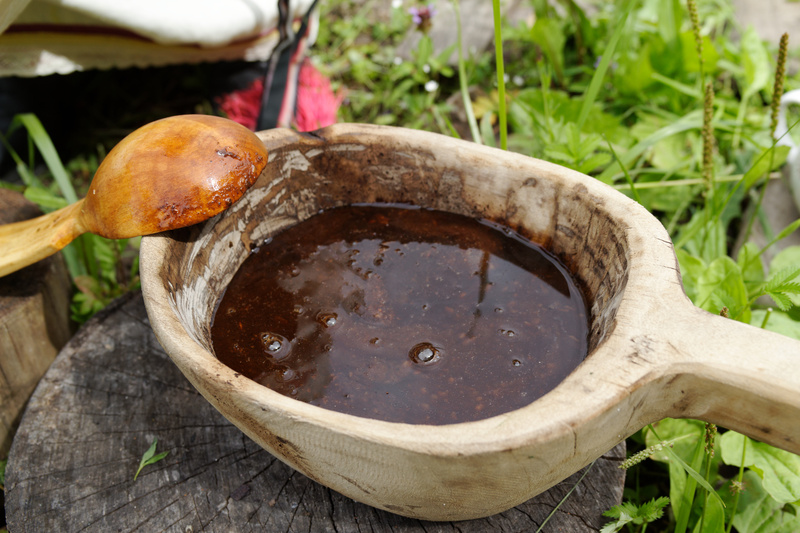
Zakvaska, with wort stirred in |
At this point Marina brought out something odd: a wooden ladle with a dark lump looking like some kind of dough in it. This, said Marina, was the zakvaska. According to Sasha, this is a Russian word that means any kind of yeast culture that hasn't been purified by a lab.
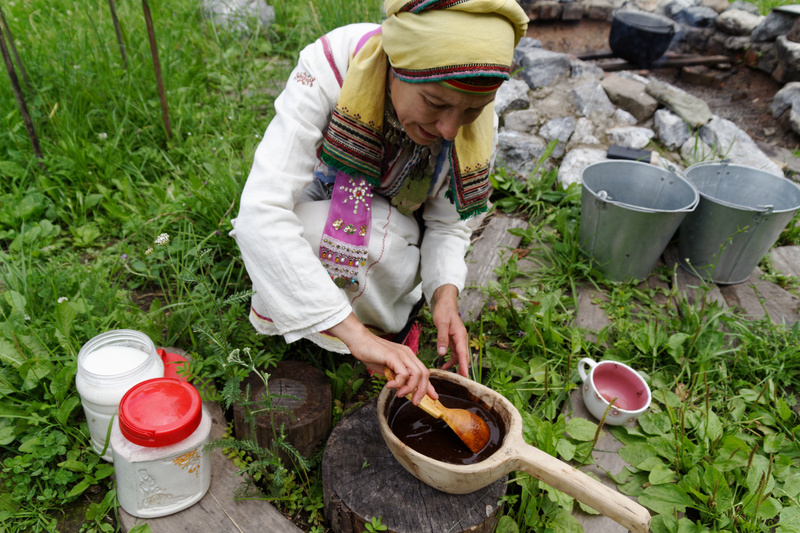
Stirring in sugar |
We asked Marina about the zakvaska and learned that this was her own yeast. She had inherited it from her mother, but she doesn't know where her mother got it. People use the same yeast for brewing, baking, and making kvass, she said. It's stored in the fridge now, but used to be stored with ice in the cellar in the old days. If it's not used for a long time it can go bad, in which case one will go to the neighbours to get fresh yeast.
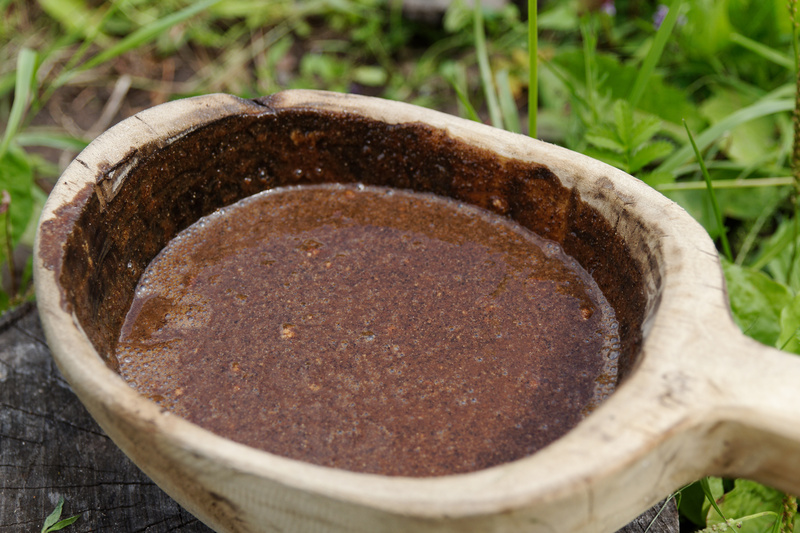
Yeast starter has been mixed (time is 12:41) |
Marina let some of the wort cool in a ladle, then stirred it into the dark lump. Then she added a good bit of sugar, stirring it in. Finally, she added rye flour in several rounds, stirring it carefully in and breaking up all the lumps, producing a strange brown liquid. Finally, it was covered up with a cloth and left to stand while the wort cooled. Which took a good while.
I asked Marina what the pitch temperature was, but she didn't know. She said she tastes the wort to decide when the temperature is right. While we waited she did this a couple of times, eventually declaring that the wort was ready. She then lifted the cloth over the zakvaska, but decided that it hadn't started enough yet, so she would wait to pitch it.
This didn't take too long, so eventually everything was ready. I of course brought out my thermometer and measured the wort before Marina pitched the yeast. 39.1C said the thermometer. Exactly the same temperature that Sigmund in Voss pitches at, and obviously way above what any commercial brewer does. But historically the standard pitch temperature in farmhouse brewing in Europe seems to have been 36-37C, so this was actually perfectly normal.
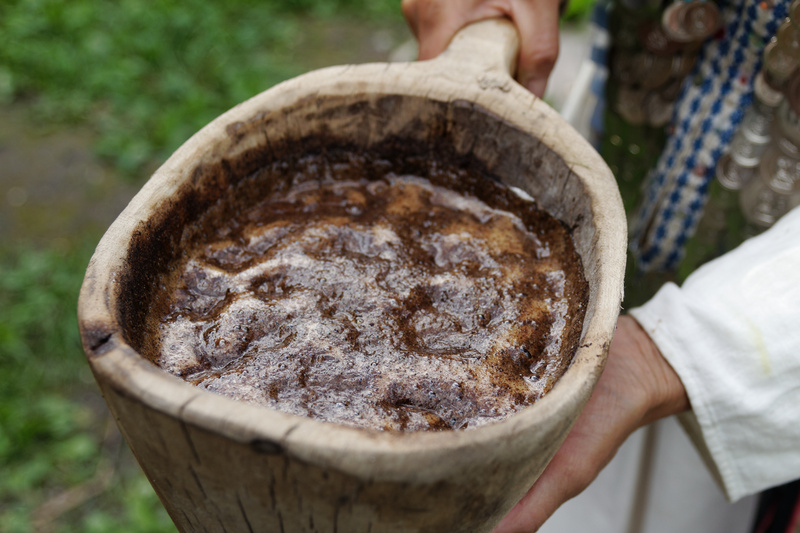
Yeast starter is ready (time is 15:47) |
Marina poured the contents of the ladle into the wort without any visible ceremony, but she told us that when she pitches the yeast she must say something in her mind. There are no fixed words, but usually she "says" something along the lines of "thank you to the universe, make the beer healthy, let the strength of the beer make us stronger." It's not quite a yeast scream, but definitely similar.
Now, the only thing left to do was clean up, and wait. Marina says she normally ferments 5-7 days before the beer is ready. By that time we would be far away from Chuvashia, unfortunately, but Marina had prepared another beer for us that had fermented for two days. It wasn't finished, but at least it gave us some idea of what the Chuvash beer was like.
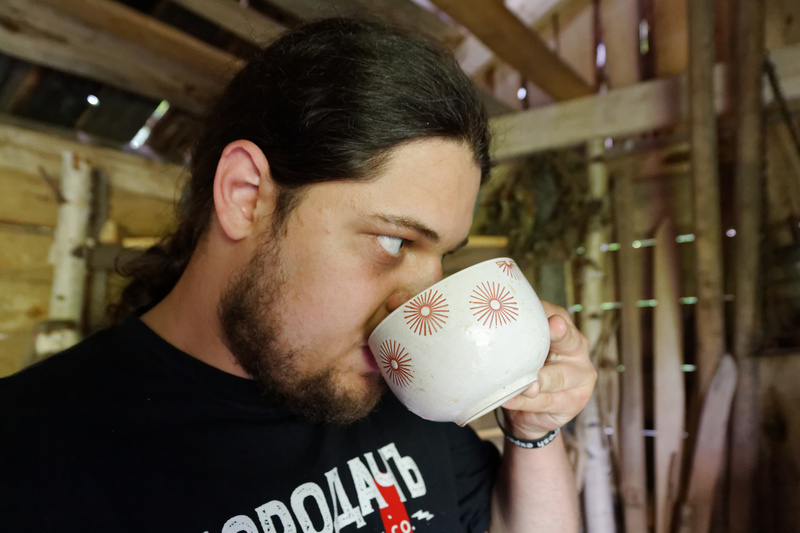
Sasha tasting the beer |
The green beer was black, dry and tart, very thin and light. No noticeable aroma of hops. No carbonation. It smelled like fresh rye bread, probably because it was still fermenting, and tasted of dark earthy rye and coffee. Nice, clean fruity notes from the yeast in the background. The finish had notes of bread crust. This clearly wasn't a strong beer, which confused me a bit. From the beer songs you'd think Chuvash beer is normally quite strong.
Of course, before we left, we asked Marina a bit about the yeast. She said having your own yeast is common in Chuvashia. In general, every family where the old grandmother is still alive will brew beer. If someone made a visit to Chuvashia to collect yeast our knowledge of farmhouse yeast could probably be expanded quite dramatically.
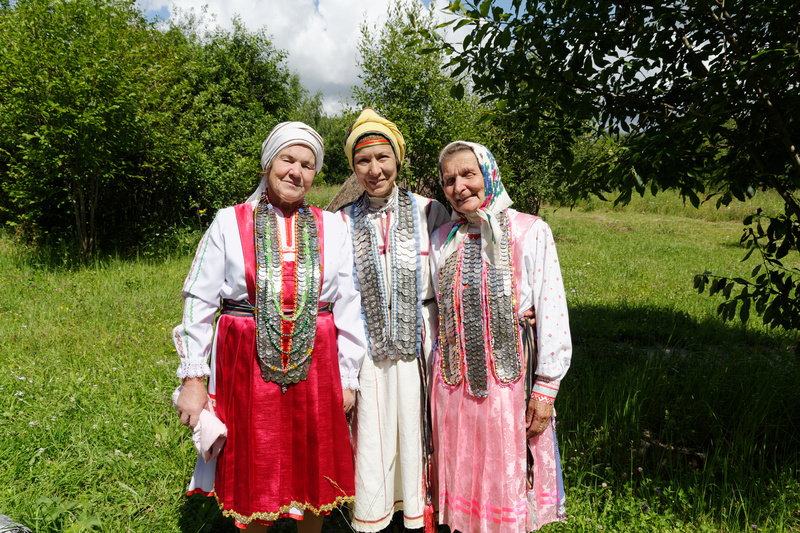
Zoya, Marina, and Anna |
I asked Marina for permission to take some of her yeast, and she said this was OK. I also asked for permission to share it, and to give it to the NCYC, even though they sell the yeast. That sounds awful, but remember the beer we tasted was actually nice. Marina thought for a moment, then said yes. Later we realized that the beer we'd tasted was fermented with a different yeast, from a woman named Rima Il'inischna Petrova. So we got a sample of that, too, and via phone managed to get permission from her, too.
Then it was time to take our leave and head back to Cheboksary, the capital of Chuvashia, where we took the night train to Moscow and the end of the journey.
Since I'm writing this a year and a half later, we now actually have some analysis results. The cultures contained bacteria, mould, and several kinds of yeast. The labs got several strains of Saccharomyces cerevisiae out of them. Test ferments produced clean, fruity aromas, and the indications so far are that these are domesticated farmhouse yeasts. Genetically, they seem not to be related to any other groups of yeasts in the tests done so far.
Very likely there is a lot more to be said about these yeasts, but we don't know it yet. Research is ongoing and will be published in due course.
The yeasts are listed in the farmhouse yeast registry as #39 and #40. They're not available commercially that I know of, but home brewers are sharing them around, and they are also available from the NCYC.
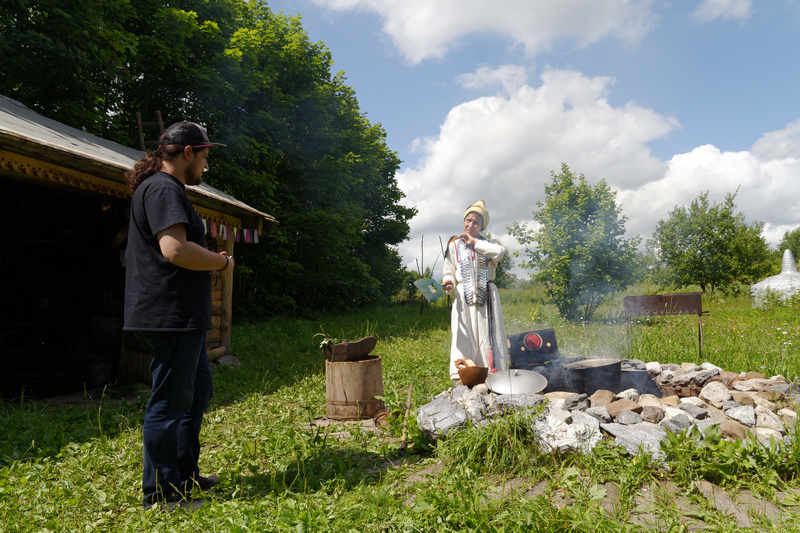
Sasha talking with Marina |
Acknowledgements
Many thanks to Dake Aachen, who first put me in contact with Yasna. Also to Aleksandr Gromov (Sasha) for arranging the dates with Yasna, and translating throughout. And to Marina, Elena, Anna, Zoya, and all the lovely people at Yasna.
Also many thanks to Richard Preiss, the NCYC, and Jan Steensels at VIB/KU Leuven for sharing their analysis results.
Similar posts
Oven beer in central Russia
Dmitriy stopped the car outside his dacha (summer house) in the tiny village of Shitovo, and jumped out
Read | 2018-11-07 19:31
The Russian farmhouse ale expedition
I used to think that Russia was a land of vodka, and that the Russians had no beer tradition
Read | 2018-08-28 19:53
Comments
David Nilsen - 2019-02-06 15:56:22
You mentioned their use of hot rocks in the wort. Are you familiar with the historical practice of stein beer made in this way? There area a few U.S. breweries - Scratch Brewing being the primary one - that are making beer in which the wort is boiled entirely with hot rocks. I can get you in touch with them if you like.
Lars Marius Garshol - 2019-02-06 15:59:31
@David: Historically, stone beer was made not by putting hot rocks in the wort, but by using them to heat the mash. So these American and other modern brewers who boil the wort with rocks are basically recreating a myth. This blog post explains why http://www.garshol.priv.no/blog/361.html
Hans Ebbing - 2019-04-29 12:55:45
I'm following your quest into traditional brewing with great pleasure and interest. In the past I did some research into the nature of the gruit which was manufactured in medieval times in the Netherlands and Germany. Ingredients of this gruit were malt (and perhaps unmalted grain), herbs and resin. In connection with my old research I find this lump of dough/yeast very interesting. Was it really a kind of dough. I mean, made with (malt)flour like you would make for baking a loaf of bread or was it more like compressed yeast.
Lars Marius - 2019-05-01 08:21:40
@Hans: I think Marina stirs rye flour into the yeast after it's harvested, and over time it semi-dries into this lump. From memory it looked like a kind of dough/putty. It's really just flour and yeast, nothing else, and definitely not a kind of bread.
In Sweden it was common to do this more systematically and create what was called "yeast cakes" from a mix of flour and yeast. These could be dried in the oven, for example, and were hung up afterwards.
Do you have references to sources describing the gruit cakes with yeast in them?
Hans Ebbing - 2019-05-01 13:34:02
Not exactly a "çake", but more like a lump of yeast dough is described in this article about White Ale in Devon, England. The 19th century author Mr. Karkeek wrote about the manufacture of White Ale and more specifically, he researched and described the ingrediënt called grout. The grout or ripening is described as the lump that started the fermentation. He had a specimen of this grout analyzed and it came back with some surprizing results. Your blog reminded me of this article. The nature of the Dutch gruit is contested. The communis opinio is that it was 'just' a mixture of herbs. My findings are that the entire gruithuis with a copper kettle, sieves, a press, a horse, a mill, a great oven or fireplace, a malt installation etc., was not just for creating a mixture of herbs. To my mind the endproduct was a porridgelike sweet liquid (possibly with an infusion of herbs) that started or helped the fermentation. The latin name for gruit being fermentum in all the latin sources. I'll link you the article of Karkeek. I'm curious to know what you think of his grout in the bigger picture of your research.
Oslobrygg - 2019-05-24 23:36:21
Benytt google translate. https://registrr.livejournal.com/tag/%D0%9A%D0%9C%D0%9A%D0%97 Her er det nok mye teknisk informasjon om hvordan vi dyrker "gjær" opp til brød, men gir god forståelse hvordan kan vill gjær kan bli dyrket til kvas/øl. Har laget kvas basert på 100% rug selv, så er det nok enkelt. Der er det reell forskning med "oppskrifter". Lykke til! :)
schnitter - 2020-03-03 07:29:36
Ларс Мариус, В приготовлении 100% ржаного фермерского пива есть маленький секрет, на который не обращают внимания домашние пивовары привыкшие к современной схеме затирания. Суть в том, что пророщенное ржаное зерно до трёх суток выдерживалось на печи в куче, плотно укрытым "зимней одеждой". В таких условиях пророщенное ржаное зерно проходило ВСЕ ТЕМПЕРАТУРНЫЕ ПАУЗЫ от 45* Цельсия до 68*-72* Цельсия. Зерно становилось СЛАДКИМ. При сушке, которая зачастую была неравномерной, часть зерно становилась карамельной, что давало вкус и "тело пива" - плотность. Размолотый солод, приготовленный подобным способом, подвергался экстракции любым удобным способом, как и его фильтрация.
Lars Marius, in the preparation of 100% rye farm beer, there is a little secret that home brewers who are used to the modern mashing scheme do not pay attention to. The bottom line is that the sprouted rye grain was kept on the stove for up to three days in a pile, tightly covered with "winter clothes". Under these conditions, sprouted rye grain passed all TEMPERATURE PAUSES from 45 * Celsius to 68*-72 * Celsius. The grain became SWEET. When drying, which was often uneven, part of the grain became caramel, which gave the taste and" body of the beer " - density. Ground malt prepared in this way was extracted in any convenient way, as was its filtration.
Kilian Cuerda - 2020-12-15 17:17:34
Hi, Lars and Schnitter. When you make a 100% rye beer of this traditional styles (or with a high amount of rye homemade malt), how to avoid that the mash turn in to a sticky paste nearly or really difficult to lauter? Perhaps the last time I shouldn't have grinded the malt too much to prevent this problem... Thank you.
Dennis - 2024-04-10 18:45:16
'Zakvaska' is sourdough literally and the word has the same stem as 'kvass', actually. The guy was mostly right: it's based on the symbiosis of yeast and lactic acid bacteria.
Talking of the cognates... it's suddenly 'hvathjan' (to become foamy) in Gothic. Or something like 'kvāthás' (decoction) in old degree of Indo-Aryan langs. Or 'сāsеus' (cheese) in Latin. Or Käse and so forth :)